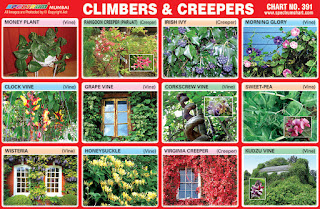 |
| Climbers & Creepers Chart |
Spectrum Chart - 391 : Climbers & Creepers
1. Money Plant - Epipremnum aureum also
known as money plant is a species of flowering plant in the family of
Araceae, native in Mo'orea, French Polynesia. The species is a
popular houseplant in temperate regions. It is often used in
decorative displays in shopping centres, offices and other public
locations largely because it requires little care and is also
attractively leafy. It is also efficient at removing indoor
pollutants such as formaldehyde, xylene and benzene.
2. Rangoon Creeper (Parijat) - Rangoon
creeper is a vine with red flower clusters and is found in Asia. It
is found in many other parts of the world either as a cultivated
ornamental or run wild. The plant is used as a herbal medicine. The
fruits are also used to combat nephritis. Leaves can be used to
relieve pain caused by fever. The roots are used to treat rheumatism.
3. Irish Ivy - Irish ivy is a woody vine
native to the Atlantic coast of Europe. It is an evergreen climbing
plant, growing to 20–30 m high where suitable surfaces (trees,
cliffs, walls) are available, and also growing as ground cover where
there are no vertical surfaces. It climbs by means of aerial rootlets
which cling to the substrate.
4. Morning Glory - Morning glory is the
common name for over 1,000 species of flowering plants in the family
Convolvulaceae. Most morning glory flowers unravel into full bloom in
the early morning. The flowers usually start to fade a few hours
before the "petals" start showing visible curling. They
prefer full solar exposure throughout the day and mesic soils.
5. Clock Vine – Clock vine is a genus of
flowering plants in the family Acanthaceae, native to tropical
regions of Africa, Madagascar and southern Asia. They are vigorous
annual or perennial vines and shrubs growing to 2-8 m tall.
6. Grape Vine – Grape vine is a genus of
79 accepted species of vining plants in the flowering plant family
Vitaceae. The genus is made up of species predominantly from the
Northern hemisphere. Grapevines are widely cultivated by gardeners.
The plants are valued for their decorative foliage, often colouring
brightly in autumn, their ability to clothe walls, pergolas and
arches, thus providing shade and their fruits, which may be eaten as
dessert.
7. Cockscrew Vine – Cockscrew vine is a
leguminous vine from the family Fabaceae, originating in tropical
South America and Central America. This perennial vine has fragrant
flowers said to be reminiscent of hyacinths - with a distinctive
curled shape. The Corkscrew Vine has highly fragrant, multicoloured,
corkscrew or spiral shaped flowers and is not an invasive plant.
8. Sweet Pea - Sweet pea is a flowering
plant in the genus Lathyrus in the family Fabaceae (legumes), native
to Sicily, southern Italy and the Aegean Islands. It is an annual
climbing plant, growing to a height of 1–2 metres, where suitable
support is available. The leaves are pinnate with two leaflets and a
terminal tendril, which twines around supporting plants and
structures, helping the sweet pea to climb.
9. Wisteria – Wisteria is a genus of
flowering plants in the pea family, Fabaceae, that includes ten
species of woody climbing vines. Wisteria is very hardy and
fast-growing. It can grow in fairly poor-quality soils, but prefers
fertile, moist, well-drained soil. They thrive in full sun. Wisteria
vines climb by twining their stems either clockwise or counter
clockwise round any available support. They can climb as high as 20 m
above the ground and spread out 10 m laterally.
10. Honeysuckle - Honeysuckles are arching
shrubs or twining bines in the family Caprifoliaceae, native to the
Northern Hemisphere. Honeysuckles are valued as garden plants, for
their ability to cover unsightly walls and outbuildings, their
profuse tubular flowers in summer and the intense fragrance of many
varieties. The hardy climbing types need their roots in shade and
their flowering tops in sunlight or very light shade.
11. Virginia Creeper - Virginia creeper is
a species of flowering plant in the grape family, Vitaceae. It is a
prolific deciduous climber, reaching heights of 20–30 m in the wild.
It is grown as an ornamental plant, because of its ability to rapidly
cover walls and buildings and its deep red to burgundy fall (autumn)
foliage. It is frequently seen covering telephone poles or trees.
12. Kudzu Vine – Kudzu vine is a group of
plants in the genus Pueraria, in the pea family Fabaceae, subfamily
Faboideae. They are climbing, coiling and trailing perennial vines
native to much of eastern Asia, Southeast Asia and some Pacific
islands. Kudzu has been used as a form of erosion control and also to
enhance the soil. As a legume, it increases the nitrogen
in the soil. Kudzu can be used by grazing animals, as it is
high in quality as a forage and palatable to livestock.

No comments:
Post a Comment